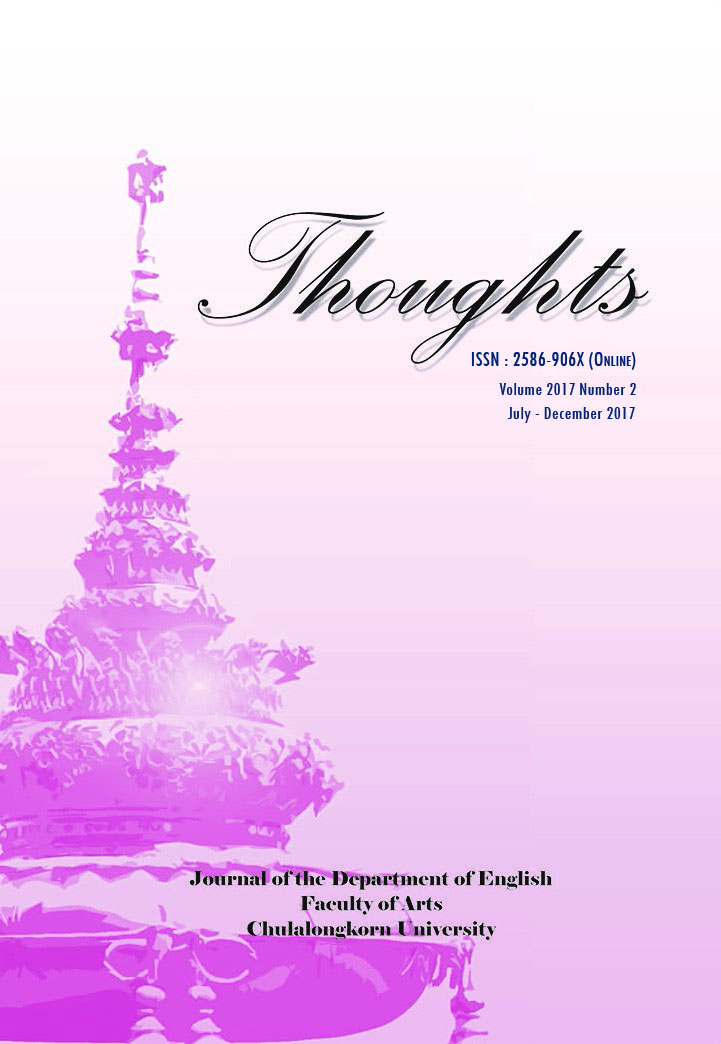An Interdisciplinary Study of the Scalar Verbs in English and Thai
Keywords:
English, novels, scalarity, Thai, verbsAbstract
In general, one of the ways to express the concepts of scales or the so-called “scalarity” is to use adjectival expressions. Recently, the concepts about scalarity have been widely discussed, as they were also found to be embedded in the verb-phrase constructions (Heinrich-Heine-Universität Düsseldorf, 2011). In the previous literature such as Levin (2009, 2010) and Rappaport Hovav (2008, 2011), scalar verbs can be classified into three types: those of property scales, volume/ extent scales, and spatial scales. As previous studies exemplified scalar verbs in single sentences (or sentences in isolation), a question arose of how non-scalar versus scalar verbs can be analyzed in the English-Thai languages in natural contexts such as literary works (Rowling, 2012; Pinpinat, 2012). This paper aims at, qualitatively, studying English-Thai verb scalarity, extracted from selected literary works and analyzed through interdisciplinary views, which included the fields of English-Thai syntax, semantics, cognitive linguistics, and literature. The results revealed that verb scalarity was found in both English and Thai literary works. However, the ways to present verb scalarity in English and Thai, as found in the literary works, differed to the fact that Thai has the serial verb constructions (Muansuwan, 2000; Sookgont et al., 2015; Sudmuk, 2005; Takahashi, 2009; Thepkanjana, 1986) to convey the concept of scalarity, whilst English does not. It is hoped that this research will shed light on to other future English and Thai interdisciplinary studies.
References
Bochnak, M.R. (2011). Two sources of scalarity within the verb phrase. In B. Arsenijevic, B.Gehrke, & R. Marin (Eds.), Subatomic semantics of event predicates. USA: University of Chicago. Retrieved from http://semanticsarchive.net/Archive/zA2ZDY0Z/Bochnak.sourcesofscalarity.pdf
Fillmore, C. J. (2003). The case for case. In Form and meaning in language. Stanford: CSLI Publications, 1-311. Retrieved from http://linguistics.berkeley.edu/~syntax-circle/syntax-group/
Framenet Project, The. (2013). Retrieved from https://framenet.icsi.berkeley.edu/fndrupal/
Heinrich-Heine-Universitat Dusseldorf. (2011). Workshop on “Scalarity in Verb-Based Constructions.” April 7-8, 2011.
Hinton, L. (1994). Flutes of fire. Essays on California Indian languages. USA: Heyday Books.
Kramsch, C. (1998). Language and Culture. In H.G. Widdowson (Ed.), Oxford Introductions to Language Study. China: Oxford University Press.
Lakoff, G., & Johnson, M. (2003). Metaphors we live by. USA: The University of Chicago Press.
Langacker, R. (1991). Concept, image, symbol. The cognitive basis of grammar. Germany: Ratzlow-Druck.
Levin, B. (2009). Lexical semantics of verbs V: Scales, scalar change, and manner/ result complementarily. A handout of the course LSA 116. University of California at Berkeley. Retrieved from web.stanford.edu/~bclevin/lsa09 scmrcomp.pdf
Levin, B. (2010). Lexical scales and verbs of scalar change. A handout of CLS 46. Retrieved from web.stanford.edu/~bclevin/cls10change.pdf
Levin, B., & Rappaport Hovav, M. (2011). Conceptual categories and linguistic categories III: More on scalar change, lexicalization and argument realization. A handout for the course LING 78000-000 CU Boulder. Retrieved from https://web.stanford.edu/~bclevin/las11mr2.pdf
Muansuwan, N. (2000). Directional serival verb constructions in Thai. Dan Flickinger and Andreas Kathol (eds.), Proceedings of the 7th International HPSG Conference. University of California at Berkeley. Retrieved from https://web.stanford.edu/group/cslipublications/ cslipublications/HPSG00/hps00muansuwan.pdf
Nara (pseudonym). (2012). Thaadaakusumaa. Bangkok: Pimkham Publishers.
Panthumetha, N. (2016). The Thai grammar. Bangkok: Chulalongkorn University Press. [in Thai].
Ozturk, O., & Papafragou, A. (2014). The acquisition of epistemic modality: From semantic meaning to pragmatic interpretation. In Language Learning and Development, 00: 1-24.DOI: 10.1080/15475441.2014.905169.
Papafragou, A., & Ozturk, O. (2007). Children’s acquisition of epistemic modality. In A. Belikova, et al. (Eds.), Proceedings of the 2nd Conference on Generative Approaches to Language Acquisition North America (GALANA), p.320-327. Somerville, MA: Cascadilla Proceedings Project. Retrieved from www.lingref.com/cpp/galana/2/paper1572.pdf
Pinpinat (pseudonym). (2012). Patamaasawan. Bangkok: Pimkham Publishers.
Prasithrathsint, A. (2010). Parts of speech in Thai: A syntactic analysis. Bangkok: A.S.P Publishers. [in Thai].
Rappaport Hovav, M. (2008). Lexicalized meaning and the internal temporal structure of events. p.13-38. Retrieved from semantics.uchicago.edu/kennedy/classes/s07/events/mrh06roth.pdf
Rappaport Hovav, M. (2011). Lexicalized Scales and Scalar Change in Two Domains. Paper presented at the Scalarity in Verb-Based Constructions Workshop. Heinrich Heine University. Germany.
Rowling, J.K. (2012). The casual vacancy. USA: Little, Brown and Company.
Rowling, J.K. (n.d.). The casual vacancy. Retrieved from https://jkrowling.com/book/the-casual-vacancy/
Slabakova, R. (2009). Scalar implicatures in second language acquisition. Lingua. DOI: 10.1016/j.lingua.2009.06.005
Smolensky, P., Goldrick, M., & Mathis, D. (2014). Optimization and quantization in gradient symbol systems: A framework for integrating the continuous and the discrete in cognition. In Cognitve Science, 38, p.1102-1138. DOI: 10.1111/cogs.120472013. Online publication: June 26, 2013, DOI: 10:1111/cogs.12047.
Smolensky, P., & Goldrick, M. (2016). Gradient symbolic representations in grammar: The case of French liaison. Retrieved from http://roa.rutgers.edu/content/article/files/1552_smolensky_1,pdf
Sookgont, S., Supnithi, T., & Kongkachandra, R. (2015). Classification of serial verb constructions in Thai. International Journal of Artificial Intelligence & Applications (IJALA), 6 (4), 79-86. Retrieved from https://www.academia.edu/14847218/Classification_of_Serial_Verb_Constructions_in_THAI
Sudmuk, C. (2005). The syntax and semantics of serial verb constructions in Thai. Ph.D. Dissertation. USA: The University of Texas at Austin. Retrieved from https://www.lib.utexas.edu/etd/d/2005/sudmud95920/ sudmuk95920.pdf
Takahashi, K. (2009). Basic serial verb construction in Thai. Journal of the Southeast Asian Linguistics Society, 1, 215-229. Retrieved from labo.kuis.ac.jp/private/kiyoko/SEALS18.pdf
Tamm, A. (2012). Scalar verb classes. Italy: Firenze University Press. Retrieved from http://cognitivescience.ceu.hu/sites/default/files/publications/ 53261.pdf
Thepkanjana, K. (1986). Serial verbs constructions in Thai. Ph.D. Dissertation. USA: The University of Michigan.
Umarika (pseudonym). (2012). Soysabanngaa. Bangkok: Pimkham Publishers.
Downloads
Published
Issue
Section
License
Copyright by the Faculty of Arts, Chulalongkorn University.
Photocopying is allowed for internal, non-commercial use only. Photocopying for other uses or for purposes other than indicated must be permitted in writing from the Faculty of Arts, Chulalongkorn University.
All views or conclusion are those of the authors of the articles and not necessarily those of the publisher or the editorial staff.


